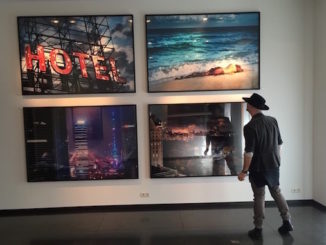With his 102nd birthday being right around the corner, acclaimed artist Eli Bornstein will mark his special day with the release of his biography, Eli Bornstein: Life & Work.
Born on December 28, 1922, in Milwaukee, Wisconsin, Bornstein always had the urge to become an artist since his days in kindergarten. Receiving encouragement from his mother, Bornstein started taking art lessons as early as age 12, went to museums, and started portraying Jewish figures within his Milwaukee community in his teens, with his artistry taking off from there.

Before establishing himself as a trailblazing abstract artist, Bornstein experimented with other forms of visual art. Throughout his childhood and teen years, he naturally did representational art of interior figures in the marketplace he would go to with his mother in Milwaukee. Step by step, he started learning from the lessons of impressionism from Paul Cezanne, Cubism, a revolutionary art movement created by Pablo Picasso and Georges Braque in the early 20th century, the early work of Piet Mondrian and Constantin Brâncusi. This helped him fairly systematically make his way through the history of modernist art learning along the way.
In 1943, Bornstein continued to pursue art at The Art Institute in Chicago, Illinois before receiving his teaching degree from the Milwaukee State Teachers’ College in 1945. Before moving to Canada, Bornstein taught at the Milwaukee Art Institute from 1943 to 1947 and at the University of Wisconsin in Milwaukee in 1949.
Based in Saskatoon, Saskatchewan since 1950 when he started teaching and later on head of the Department of Fine Arts at the University of Saskatchewan, one can find many of Bornstein’s pieces in the area. His first commissioned piece, created in 1956, is the “Tree of Knowledge,” a 15-foot bronze statue located outside of the Saskatchewan Teacher’s Federation building. The bronze statue is the first abstract statue in Saskatoon, and it caused discrete controversies, resistance, and hate. The editor of a local newspaper received letters demanding for Bornstein’s termination at the University of Saskatchewan. Despite being a major affair, it’s an important piece that remains standing.
Bornstein didn’t stop there and continued to create more abstract art pieces.
In 1984, Bornstein created a magnificent tall, four-part double vertical double plane structurist that hangs from the ceiling in the multi-story Authority building, part of the Wascana Centre Authority in Regina.
A monumental relief on the grounds of the University of Saskatchewan, The “Exoplanet Doctors Relief,” sits on a park setting of the campus. Originally, the abstract piece was intended for a synchrotron for the university’s Canadian Light Source Building. However, the sculpture is now placed in its current location after the building’s renovation.
Another splendid abstract piece is the “Tri-part Hexaflame Construction,” a three-part free standing relief, an outside installation on the University of Manitoba’s campus.
As a modern abstract relief artist, it makes sense to call Bernstein a loner. As a relief artist, he essentially drew inspiration from his study of nature when abstract painting was supposed to be essentially subjectless. He was a unique artist on the Canadian Prairies who came into maturity when the reigning aesthetic of the time was colour field painting, which was promoted by American critic Clement Greenberg. Colour field painting was the reigning aesthetic that demanded that painting celebrate its flatness.
Roald Nasgaard, a teacher, writer and curator, is the author of the upcoming biography, Eli Bornstein: Life & Work. In 2008, wrote a book called Abstract Painting in Canada. The book took him across the country interviewing abstract artists. It was then that he met Bornstein for the first time and found his work to be very impressive. Some years later, when Nasgaard was installing his art exhibition, The Automatists Revolution, a Bornstein exhibition in the adjacent galleries was taking place. These adjacent galleries had skylights, meaning the appearances of the pieces would change as the day progressed, representing how Bornstein installed pieces in his house and studio with the use of a skylight he created that represented natural lighting. This made Nasgaard realize it was time for Bornstein to fully receive his due.
The biography is a comprehensive book that deals with the totality of Bornstein’s biography, the importance and significant critical issues and his technical means. The book’s official release will be on December 20, 2024.




